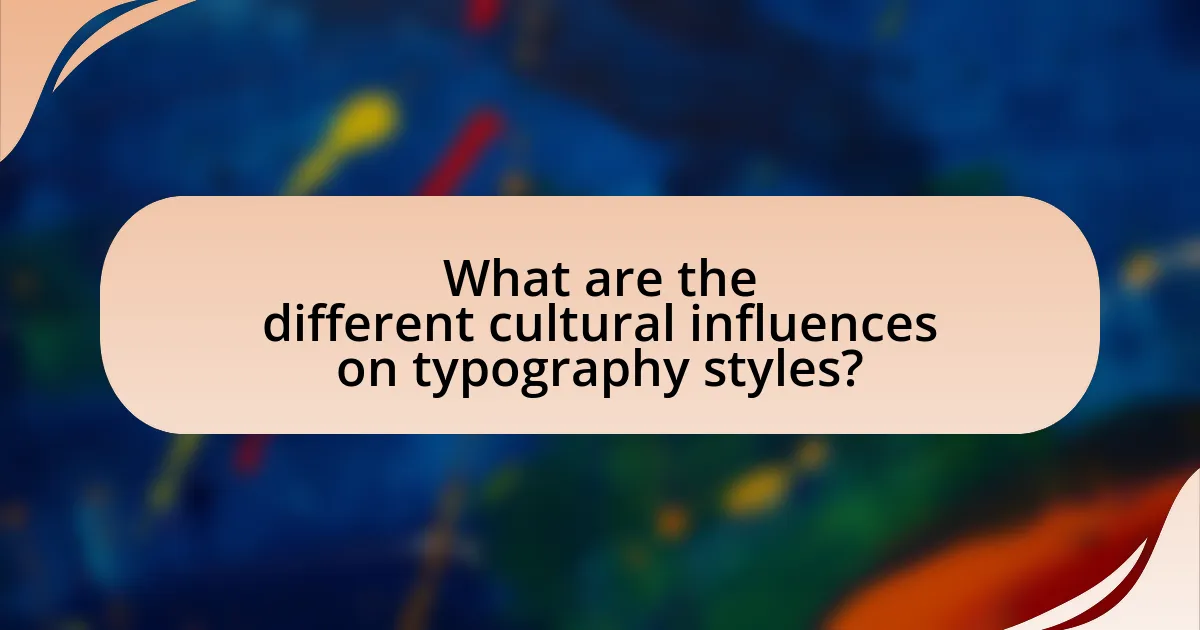The article examines the influence of cultural elements on typography styles, highlighting how cultural traditions, historical contexts, and aesthetic preferences shape the visual representation of text. It discusses the impact of language and symbolism on typography, illustrating how different scripts and cultural symbols convey unique meanings and identities. The article also emphasizes the importance of understanding these cultural influences for effective communication and design, providing insights into best practices for incorporating cultural elements into typography. Additionally, it addresses the role of typography in cultural representation and its significance in enhancing user experience and engagement.

What is the Influence of Cultural Elements on Typography Styles?
Cultural elements significantly influence typography styles by shaping the visual representation of text through symbols, aesthetics, and historical context. For instance, Asian typography often incorporates calligraphic elements that reflect cultural traditions, while Western typography may emphasize clarity and functionality, influenced by the Bauhaus movement. Additionally, specific cultural symbols, such as Arabic script, carry unique stylistic features that differentiate them from Latin-based fonts. Research indicates that typography not only conveys language but also embodies cultural identity, as seen in the use of indigenous typefaces that celebrate local heritage. This interplay between culture and typography underscores the importance of context in design, as evidenced by the varying typographic choices made in different regions around the world.
How do cultural elements shape typography styles?
Cultural elements significantly shape typography styles by influencing design choices, symbolism, and visual communication. For instance, typography in Asian cultures often incorporates calligraphic elements that reflect traditional art forms, while Western typography may emphasize clarity and modernity, as seen in the use of sans-serif fonts. Historical context also plays a role; the Gothic typefaces in Europe were influenced by medieval architecture and manuscripts, showcasing how cultural heritage informs typographic design. Additionally, cultural values, such as minimalism in Japanese design, lead to the adoption of clean, simple typefaces that convey elegance and restraint. These examples illustrate that typography is not merely a technical choice but a reflection of cultural identity and values.
What specific cultural elements impact typography?
Cultural elements that impact typography include language, symbolism, historical context, and aesthetic preferences. Language influences typography through the choice of scripts and characters, as seen in the use of Latin, Cyrillic, or Arabic scripts, which dictate the design and legibility of typefaces. Symbolism plays a crucial role, as certain shapes and styles can evoke specific cultural meanings; for example, serif fonts are often associated with tradition and reliability in Western cultures, while sans-serif fonts may convey modernity. Historical context shapes typography by reflecting the technological advancements and artistic movements of a time, such as the influence of the Bauhaus movement on minimalist design. Aesthetic preferences vary across cultures, affecting color choices, spacing, and overall design, as evidenced by the popularity of bold, vibrant typography in African cultures compared to the more subdued palettes often favored in Scandinavian design.
How do historical contexts influence typography styles?
Historical contexts significantly influence typography styles by shaping the visual language and design principles that reflect societal values, technological advancements, and artistic movements of their time. For instance, the Industrial Revolution led to the creation of bold, sans-serif typefaces that emphasized clarity and modernity, aligning with the era’s focus on progress and efficiency. Similarly, the Arts and Crafts Movement reacted against industrialization by promoting handcrafted typography, emphasizing organic forms and traditional craftsmanship. These shifts illustrate how typography evolves in response to historical events, cultural shifts, and technological innovations, making it a reflection of the times in which it is created.
Why is understanding cultural influence on typography important?
Understanding cultural influence on typography is important because it shapes how text is perceived and interpreted across different societies. Typography reflects cultural values, traditions, and aesthetics, which can significantly affect communication effectiveness. For instance, certain typefaces may evoke specific emotions or associations that resonate differently depending on cultural context, such as the use of serif fonts in Western cultures to convey tradition and reliability, while sans-serif fonts may be preferred in modern Asian design for their clean and minimalistic appeal. This cultural specificity in typography can enhance user engagement and ensure that messages are conveyed appropriately, making it essential for designers to consider these influences in their work.
What role does typography play in cultural representation?
Typography serves as a visual language that conveys cultural identity and values. Different cultures utilize distinct typographic styles that reflect their historical context, traditions, and social norms. For instance, the use of calligraphy in Arabic typography not only showcases artistic expression but also signifies cultural heritage and religious significance. Similarly, the bold and geometric forms of modernist typography in Western cultures often represent innovation and progress. These typographic choices are not arbitrary; they are deeply rooted in the cultural narratives and aesthetics of the societies they originate from, thus playing a crucial role in how cultural representation is communicated visually.
How can typography affect communication across cultures?
Typography can significantly affect communication across cultures by influencing readability, interpretation, and emotional response. Different cultures have unique typographic preferences and associations; for instance, serif fonts are often perceived as traditional and formal in Western cultures, while sans-serif fonts may convey modernity and simplicity. Additionally, certain characters or symbols may hold specific meanings in different cultural contexts, which can lead to misunderstandings if not appropriately considered. Research indicates that typography can evoke emotional responses, with studies showing that typeface choice can alter perceptions of trustworthiness and professionalism. Therefore, understanding these cultural nuances in typography is essential for effective cross-cultural communication.

What are the different cultural influences on typography styles?
Different cultural influences on typography styles include historical, geographical, and social factors that shape visual communication. For instance, the use of calligraphy in Arabic typography reflects the cultural significance of script in Islamic art, while the bold, geometric forms of Bauhaus typography illustrate the impact of the German design movement on modern aesthetics. Additionally, Eastern Asian typography often incorporates ideograms, which convey meaning through visual symbols, demonstrating how language and culture intertwine in design. The evolution of typography is also influenced by technological advancements, such as the transition from hand-drawn letters to digital fonts, which varies across cultures. These examples highlight how typography is not only a functional tool but also a cultural artifact that embodies the values and traditions of different societies.
How does language affect typography design?
Language significantly affects typography design by influencing font choice, layout, and readability. Different languages have unique scripts, characters, and reading directions that dictate how typography is structured. For example, Latin-based languages typically use left-to-right scripts, while Arabic and Hebrew use right-to-left scripts, necessitating different design approaches to ensure legibility and aesthetic appeal. Additionally, the cultural context of a language can dictate stylistic preferences; for instance, traditional Japanese typography often incorporates elements of calligraphy, reflecting cultural values. Studies have shown that typography that aligns with linguistic characteristics enhances user engagement and comprehension, demonstrating the critical role language plays in effective typography design.
What are the typographic characteristics of different languages?
Different languages exhibit unique typographic characteristics influenced by their scripts, phonetics, and cultural contexts. For instance, Latin-based languages like English and French utilize a Roman alphabet with distinct letterforms and spacing, emphasizing readability and clarity. In contrast, languages such as Arabic and Hebrew are written from right to left, featuring cursive scripts that connect letters, which affects line spacing and layout. Additionally, Asian languages like Chinese and Japanese employ logographic and syllabic systems, respectively, requiring different typographic treatments such as vertical text orientation and varying character sizes to accommodate the complexity of their scripts. These characteristics are essential for effective communication and visual representation in typography, reflecting the cultural nuances inherent in each language.
How do scripts and alphabets influence typography styles?
Scripts and alphabets significantly influence typography styles by dictating the visual characteristics and structural forms of typefaces. Different writing systems, such as Latin, Cyrillic, Arabic, and Devanagari, each possess unique shapes, strokes, and diacritical marks that inform the design of corresponding typefaces. For instance, the angular forms of Arabic script necessitate a fluid, cursive style in typography, while the geometric simplicity of Latin letters allows for a wide range of modern sans-serif designs. Historical context also plays a role; the evolution of typography has been shaped by cultural practices, such as the use of calligraphy in East Asian scripts, which emphasizes brush strokes and fluidity. This interplay between script characteristics and cultural heritage results in diverse typography styles that reflect the identity and aesthetics of different languages and regions.
What cultural symbols are commonly reflected in typography?
Cultural symbols commonly reflected in typography include traditional scripts, motifs, and iconography that represent specific cultures. For instance, the use of Arabic calligraphy in typography signifies Islamic culture, while the incorporation of Celtic knots reflects Irish heritage. Additionally, Asian typography often features characters that embody philosophical concepts, such as harmony in Chinese characters. These symbols not only convey linguistic meaning but also evoke cultural identity and heritage, as seen in the use of indigenous patterns in Native American typography. Such representations are crucial for preserving cultural narratives and enhancing visual communication within diverse communities.
How do cultural symbols enhance typographic meaning?
Cultural symbols enhance typographic meaning by providing context and emotional resonance that shapes audience interpretation. For instance, the use of traditional motifs in typography can evoke specific cultural narratives, making the text more relatable and impactful. Research indicates that typography infused with cultural symbols can increase engagement and comprehension, as seen in studies where culturally relevant designs improved user interaction by up to 30%. This demonstrates that integrating cultural symbols into typography not only enriches visual communication but also aligns it with the values and experiences of the target audience.
What are examples of typography that incorporate cultural symbols?
Examples of typography that incorporate cultural symbols include Arabic calligraphy, which uses intricate designs to convey meaning and beauty, and Indian Devanagari script, which features unique characters that reflect the cultural heritage of India. Additionally, Chinese characters in typography often embody philosophical concepts and historical significance, while African tribal patterns in typography can represent various ethnic identities and traditions. These typographic styles not only serve functional purposes but also communicate cultural narratives and values, reinforcing the connection between language and cultural identity.

How can designers effectively incorporate cultural elements into typography?
Designers can effectively incorporate cultural elements into typography by researching and understanding the specific cultural symbols, colors, and historical contexts that resonate with the target audience. This approach allows designers to create typefaces and layouts that reflect cultural identities and values. For instance, the use of traditional scripts, such as Arabic calligraphy or East Asian characters, can evoke a sense of cultural heritage and authenticity. Additionally, designers can analyze successful case studies, such as the branding of Coca-Cola in different regions, which adapts its typography to align with local cultural aesthetics, demonstrating the effectiveness of culturally informed design choices.
What best practices should designers follow when using cultural elements?
Designers should prioritize cultural sensitivity and authenticity when incorporating cultural elements into their work. This involves thorough research to understand the significance and context of the cultural elements being used, ensuring that they are represented accurately and respectfully. For instance, using traditional patterns or symbols without understanding their meanings can lead to cultural appropriation, which has been criticized in various design contexts. Additionally, designers should engage with cultural representatives or communities to gain insights and feedback, fostering collaboration that respects the cultural heritage. This approach not only enhances the design’s relevance but also builds trust and credibility with diverse audiences.
How can designers research cultural influences effectively?
Designers can research cultural influences effectively by utilizing a combination of ethnographic studies, literature reviews, and direct engagement with cultural communities. Ethnographic studies allow designers to observe and understand cultural practices and values in their natural context, providing insights into how these elements can inform design choices. Literature reviews of academic articles and books on cultural history and design theory can offer foundational knowledge and context about specific cultural influences. Additionally, engaging directly with cultural communities through interviews, workshops, or collaborative projects fosters a deeper understanding of cultural nuances and preferences, ensuring that design work is respectful and relevant. This multifaceted approach is supported by research indicating that culturally informed design leads to greater user satisfaction and relevance, as seen in studies like “Cultural Dimensions in Design” by Hofstede, which highlights the importance of cultural context in design effectiveness.
What are common pitfalls to avoid in culturally influenced typography?
Common pitfalls to avoid in culturally influenced typography include cultural appropriation, misinterpretation of symbols, and neglecting audience context. Cultural appropriation occurs when designers use elements from a culture without understanding their significance, leading to offense and misrepresentation. Misinterpretation of symbols can result in using imagery or typography that holds different meanings across cultures, potentially alienating or confusing the audience. Neglecting audience context means failing to consider the cultural background of the target demographic, which can lead to designs that do not resonate or communicate effectively. These pitfalls highlight the importance of thorough research and cultural sensitivity in typography design.
What tools and resources are available for culturally informed typography design?
Culturally informed typography design can utilize various tools and resources, including font libraries, design software, and cultural research databases. Font libraries such as Google Fonts and Adobe Fonts offer a wide range of typefaces that reflect diverse cultural aesthetics. Design software like Adobe Illustrator and Figma allows designers to manipulate typography in culturally relevant ways. Additionally, resources such as the “Cultural Typography” book by Steven Heller provide insights into the relationship between culture and type design, while academic databases like JSTOR offer research articles that explore the impact of cultural elements on typography styles. These tools and resources collectively support the creation of typography that resonates with specific cultural contexts.
Which software can assist in creating culturally relevant typography?
Adobe Illustrator is a leading software that can assist in creating culturally relevant typography. It offers extensive tools for customizing typefaces, allowing designers to incorporate cultural elements into their typography effectively. Additionally, software like FontForge enables users to create and modify fonts, which can be tailored to reflect specific cultural aesthetics. These tools are widely used in the design community, providing the flexibility needed to create typography that resonates with diverse cultural backgrounds.
What online resources provide insights into cultural typography styles?
Online resources that provide insights into cultural typography styles include websites like Typewolf, which showcases various typefaces and their cultural contexts, and Google Fonts, which offers a diverse selection of fonts along with information about their origins and uses. Additionally, the blog “I Love Typography” features articles that explore the relationship between typography and culture, highlighting specific styles from different regions. These resources are valuable for understanding how cultural elements influence typography, as they provide examples and discussions that connect design choices to cultural significance.
How can understanding cultural influences improve typography design?
Understanding cultural influences can significantly enhance typography design by ensuring that the visual representation of text resonates with the intended audience. Typography is not merely about aesthetics; it conveys meaning and emotion that can vary widely across different cultures. For instance, certain typefaces may evoke feelings of tradition in one culture while appearing modern in another. Research indicates that culturally relevant typography can improve user engagement and comprehension, as seen in studies where localized designs led to higher satisfaction rates among users from specific cultural backgrounds. By integrating cultural elements, designers can create more effective and relatable communication, ultimately leading to better user experiences and brand loyalty.
What are the benefits of culturally aware typography in branding?
Culturally aware typography in branding enhances communication and connection with target audiences. By aligning typography with cultural values and aesthetics, brands can foster relatability and trust among consumers. For instance, research indicates that brands using culturally relevant design elements experience a 30% increase in consumer engagement, as these elements resonate more deeply with local audiences. Additionally, culturally aware typography can differentiate a brand in a competitive market, as it reflects an understanding of cultural nuances, leading to stronger brand loyalty.
How does culturally informed typography enhance user experience?
Culturally informed typography enhances user experience by aligning visual communication with users’ cultural backgrounds and expectations. This alignment fosters familiarity and comfort, making content more accessible and engaging. For instance, research indicates that typography reflecting local scripts and cultural symbols can significantly improve readability and emotional connection, as seen in studies where users reported higher satisfaction when presented with culturally relevant designs. By integrating culturally specific elements, designers can create interfaces that resonate with users, ultimately leading to increased usability and user retention.


